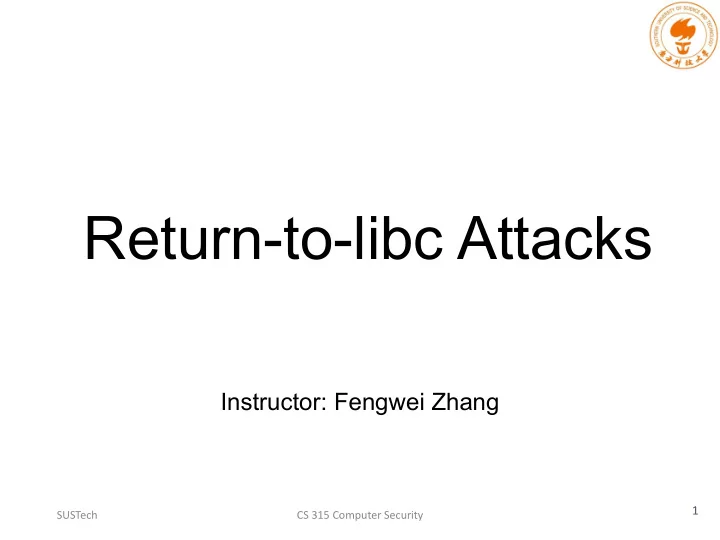

Return-to-libc Attacks Instructor: Fengwei Zhang 1 SUSTech CS 315 Computer Security
Outline ● Non-executable Stack countermeasure ● How to defeat the countermeasure ● Tasks involved in the attack ● Function Prologue and Epilogue ● Launching attack 2
Non-executable Stack Running shellcode in C program Calls shellcode 3
Non-executable Stack ● With executable stack ● With non-executable stack 4
How to Defeat This Countermeasure Jump to existing code: e.g. libc library. Function: system(cmd): cmd argument is a command which gets executed. 5
Environment Setup Buffer overflow problem This code has potential buffer overflow problem in vul_func() 6
Environment Setup “Non executable stack” countermeasure is switched on , StackGuard protection is switched off and address randomization is turned off . Root owned Set-UID program. 7
Overview of the Attack Task A : Find address of system() . To overwrite return address with system()’s ● address. Task B : Find address of the “/bin/sh” string. To run command “/bin/sh” from system() ● Task C : Construct arguments for system() To find location in the stack to place “/bin/sh” ● address (argument for system()) 8
Task A : To Find system() ’s Address. Debug the vulnerable program using gdb ● Using p (print) command, print address of ● system() and exit(). 9
Task B : To Find “/bin/sh” String Address Export an environment variable called “ MYSHELL ” with value “ /bin/sh ”. MYSHELL is passed to the vulnerable program as an environment variable, which is stored on the stack. We can find its address. 10
Task B : To Find “/bin/sh” String Address Export “ MYSHELL ” environment variable and execute the code. Code to display address of environment variable 11
Task B : Some Considerations ● Address of “MYSHELL” environment variable is sensitive to the length of the program name. ● If the program name is changed from env55 to env77, we get a different address. 12
Task C : Argument for system() Arguments are accessed with respect to ebp . ● Argument for system() needs to be on the stack. ● Need to know where exactly ebp is after we have “returned” to system(), so we can put the argument at ebp + 8 . Frame for the system() function 13
Task C : Argument for system() Function Prologue esp : Stack pointer ebp : Frame Pointer 14
Task C : Argument for system() Function Epilogue esp : Stack pointer ebp : Frame Pointer 15
Function Prologue and Epilogue example 1 2 1 Function prologue 8(%ebp) ⇒ %ebp + 8 Function epilogue 2 16
How to Find system()’s Argument Address? Change ebp and esp Modified Use of system() vul_func() Return system()’s prologue epilogue argument Address In order to find the system() argument, we need to understand ● how the ebp and esp registers change with the function calls. Between the time when return address is modified and system ● argument is used, vul_func() returns and system() prologue begins. 17
Memory Map to Understand system() Argument 18
Flow Chart to understand system() argument Return address is ebp is replaced by changed to system() esp after vul_func() Jump to system() address. epilogue “/bin/sh” is ebp is set to current system() prologue stored in ebp+8 value of esp is executed Check the memory map ebp + 4 is treated as return address of system(). We can put exit() address so that on system() return exit() is called and the program doesn’t crash. 19
Malicious Code ebp + 12 ebp + 8 ebp + 4 20
Launch the attack ● Execute the exploit code and then the vulnerable code 21
Summary ● The Non-executable-stack mechanism can be bypassed ● To conduct the attack, we need to understand low- level details about function invocation ● The technique can be further generalized to Return Oriented Programming (ROP) 22
Recommend
More recommend